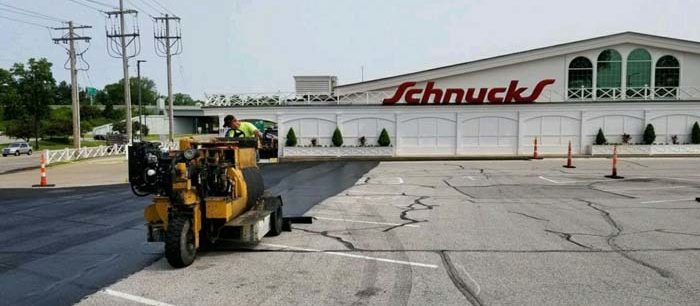All about A1 Professional Asphalt & Sealing Llc
Table of ContentsA1 Professional Asphalt & Sealing Llc for DummiesThe Single Strategy To Use For A1 Professional Asphalt & Sealing LlcSome Known Details About A1 Professional Asphalt & Sealing Llc The Best Strategy To Use For A1 Professional Asphalt & Sealing LlcA Biased View of A1 Professional Asphalt & Sealing Llc

The oil in an auto engine is not just oil. It consists of a variety of additives to boost the automobile's performance. These consist of polymers, thickness modifiers, heat stabilizers, added lubricants, and put on additives. The REOB has all the additives that remained in the waste oil as well as the wear steels from the engine (primarily iron and copper).
Nonetheless, by making numerous blends utilizing different REOB examples and various asphalt binders, the variants mostly can be averaged out. Numerous States provided examples of well-known REOB make-up to TFHRC researchers, who assessed the examples to compare the portion of added (known) REOB to the discovered (checked) quantity. The analyses showed a similar percent of added and found REOB.
A1 Professional Asphalt & Sealing Llc - An Overview
They got a frustrating action. The TFHRC researchers analyzed 1,532 examples from 40 States, one Canadian province, and two Federal Lands Highway departments. They evaluated each example twiceamounting to greater than 3,000 analyses. None of those States understood that the asphalt they were buying had REOB. One State urged its samples had no REOB.
Of the 1,532 examples evaluated, 12 percent had REOB, and some had appreciably high degrees of it at 1020 percent. The highest degree was 34 percent in a sample from Texas, which TxDOT had used in a patching substance. This screening also revealed the visibility of phosphoric acid in 11 percent of the examples, and 2 percent included ground tire rubber.
Two years ago at TRB's yearly meeting, the Federal researchers held an REOB workshop and offered the findings of their lab examinations to a standing room-only crowd. Although some companies do not specifically outlaw REOB, they do enforce physical tests that avert its useeffectively a restriction. asphalt sealcoating in st louis. Others do not prohibit it by specification, yet have contracts with asphalt suppliers to avoid making use of REOB
8 Simple Techniques For A1 Professional Asphalt & Sealing Llc
Ohio and Texas limit degrees to much less than 5 percent of the asphalt. To develop a reputable test method that all States can utilize, the TFHRC scientists set up a round-robin examination plan.
The participants are testing the examples individually using the guidelines provided by the TFHRC researchers. The output will certainly be a suggested AASHTO examination technique that any State can take on and utilize.
The pavement with REOB, which lies 0.6 mile (1 kilometer) from the pavement without REOB, has the same subgrade, traffic density, and climate. Nevertheless, the section of Highway655 with 5 to 10 percent REOB showed substantial fracturing. In this example, the presence of REOB was the determined source of splitting at a low temperature levels.
A section of examination pavement in Minnesota (MN1-4) located to include REOB additionally fractured too soon. The pavement carried out well for the initial 3 to 4 years, but after that began to fracture.
A1 Professional Asphalt & Sealing Llc Can Be Fun For Everyone
The examinations were not comprehensive, however they showed that at levels of 6 percent or more, the tensile toughness of the asphalt went down significantly. At a degree of 3.5 percent REOB, the variation in the physical test techniques was higher than the result of REOB. Actually, it was difficult for researchers to assess whether REOB was existing.

One binder parameter thought about is the difference between the low temperature level crucial specification temperature level for tightness (S) in the bending beam rheometer and the flexing light beam rheometer creep incline (m-value) noted as Tcritical. 2 independent research groups, one from AASHTO and the various other from the Asphalt Institute, concluded that more research is required on the use of REOB in asphalt.
Previously, all asphalt testing measured design residential or commercial properties such as stiffness. These examinations do not reveal what materials had been contributed to the asphalt. One example received throughout the TFHRC research had an extremely strange evaluation. The example had the following examination outcomes: Superpave PG 64-28 with a heat quality of 67.3 Tcritical on the bending beam rheometer was 6.7 levels Celsius.

An Unbiased View of A1 Professional Asphalt & Sealing Llc
These outcomes show there are weaknesses in the standardized design screening protocols that may be manipulated. The producer may have an economic benefit and the item passes all the standardized examinations, yet the item might not be beneficial to guaranteeing long-term efficiency. To resolve this problem and the growth of new asphalt additives and extenders, TFHRC is starting a research program to use portable spectroscopic tools, x-ray fluorescence spectroscopy, and Fourier transform infrared spectroscopy to enable analyses to be performed in the field instead of needing to take samples back to the lab.